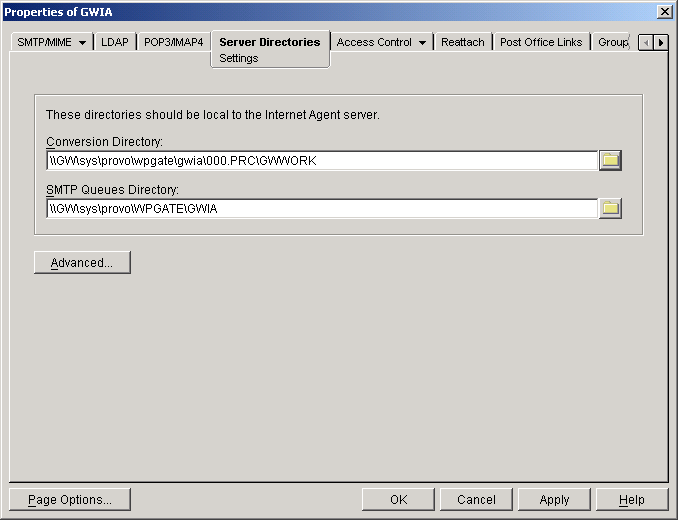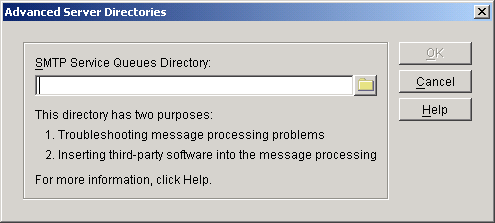Relocating the Internet Agent's Processing Directories
The Internet Agent uses several directories to process message files. By default, when you install the Internet Agent to a NetWare® server, these directories are created under the Internet Agent's gateway directory (domain\wpgate\gwia). To increase performance, you can relocate these directories to the same server as the NetWare Internet Agent.
To define the location of the Internet Agent's directories:
-
In ConsoleOne®, right-click the Internet Agent object, then click Properties.
-
Click Server Directories > Settings to display the Server Directories Settings page.

-
Fill in the fields:
Conversion Directory: Select the directory where the Internet Agent will store temporary files for message conversion. The default directory is the 000.prc\gwwork directory, located under the domain\wpgate\gwia directory when using the NetWare or Linux Internet Agent, or the c:\grpwise\gwia directory when using the Windows Internet Agent.
If you type a path to a Windows drive (rather than using the Browse button to select the directory), you must use UNC path syntax.
This setting corresponds with the Internet Agent's /work switch.
SMTP Queues Directory: Select the directory where the Internet Agent will store messages being routed to and from the Internet. The default directory when using the NetWare or Linux Internet Agent is domain\wpgate\gwia. The default directory when using the Windows Internet Agent is the Internet Agent directory on the Windows server (by default, c:\grpwise\gwia). Four subdirectories are created under the SMTP queues directory: defer, send, receive, and result.
This setting corresponds with the Internet Agent's /dhome switch.
-
Click the Advanced button.

-
Fill in the field:
SMTP Service Queues Directory: If you want, specify a secondary SMTP queues directory for outbound messages. This secondary directory can be helpful for troubleshooting by providing a way to trap messages before they are routed to the Internet. You can also use the secondary directory to run third-party utilities such as a virus scanner on Internet-bound messages.
The Internet Agent will place all outbound messages in this secondary directory. The messages must then be moved manually (or by another application) to the primary SMTP queues' send directory (see Step 3) before the Internet Agent will route them to the Internet.
This setting corresponds with the /smtphome switch.
If you type a directory path rather than using the Browse button to select a directory, make sure you use UNC path syntax.
-
Click OK to close the dialog box.
-
Click OK to save the changes to the directory locations.